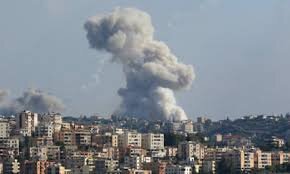Israel will fail to split anti-colonial resistance by attack on Lebanon

MADRID- The massive bombardment by the Israeli army in eastern and southern Lebanon on Monday resulted in about 560 deaths and at least 1,1850 injuries, overwhelming the already strained hospitals in the country. This escalation raises the risk of a total war and intensifies calls for an arms embargo against Israel.
Local media described the attack as "the deadliest since the war between Israel and Hezbollah in 2006." This assault came just days after the Israeli army detonated thousands of electronic devices across Lebanon, leading to dozens of fatalities and leaving thousands more injured, an act that experts—including former CIA Director Leon Panetta—have labeled terrorism.
Hezbollah, through its deputy leader Naim Qassim, announced that "the war has entered a new phase," likely leading to further displacement of Israeli settlers. Recent rocket attacks by the Lebanese resistance have forced tens of thousands of residents from various cities and towns to seek refuge. Schools have been closed, and reports indicate that hospitals have been instructed to relocate injured individuals to underground shelters.
Hezbollah initiated a campaign of attacks against Israel just as the latter unleashed its full genocidal potential on Gaza. The Lebanese group's strategy, like that of the other members of the so-called Axis of Resistance, aims to divert attention from Gaza to alleviate Palestinian suffering. In this context, the Axis of Resistance has developed the strategy of uniting all fronts, recognizing Palestine's centrality in formulating military strategies against colonial occupation. For instance, the Yemeni attacks in the Red Sea exemplify this strategy.
The term "Unity of Fronts" gained traction after the "Sword of Jerusalem" battle launched by Hamas in May 2021, which defended the Al-Aqsa Mosque and responded to repeated violations by Israeli forces, as well as attempts to displace residents from the Sheikh Jarrah neighborhood in Jerusalem.
In practice, "Unity of Fronts" involves mobilizing multiple fields and fronts simultaneously against the Israeli enemy, even when a specific resistance movement initiates a battle for particular reasons. It is crucial to view this "unity of fronts" as a movement with a clear goal: the defeat of Israel, although it does not conform to a singular, centralized vision regarding strategies and timelines. Thus, while there are shared objectives, this does not imply a vertical subordination to a specific mode of action. Both Hezbollah and other members follow their own logics and strategies, consistently keeping the liberation of Palestine at the core of their concerns.
Israel's response, backed by its Western sponsors and allies, has consisted of a campaign that addresses each front in isolation, aiming to collectively dissociate them from Gaza and from one another. However, it is evident that this objective has not been achieved and all indications suggest that it will not be realized in the future. Hezbollah’s support for Gaza exemplifies this unity across all fronts, with a strategy focused on intensifying the erosion of the occupying army to prevent it from deploying its full force against Gaza and to weaken its internal front.
Through an unprecedented operation in the history of the Arab-Israeli conflict, around 250,000 settlers were forced to live in insecure conditions. Half of them completely vacated the settlements, while the other half has endured significant suffering since October 8. During this period, the confrontation adhered to precise rules that limited the enemy's responses to the framework established by the resistance.
The resistance has incurred high costs, both in terms of its military structure and the loss of leaders and fighters. It has also had to manage the special needs of approximately 100,000 displaced Lebanese from frontline villages. For over 11 months, the resistance's plan operated effectively, which only heightened Israel's anger. Realizing it could not stop the fighting in the north without curtailing the combat in the south, Israel decided to change the rules of engagement.
This shift involves applying the Gaza model—marked by destruction and death—to Lebanon, aiming to subdue Hezbollah and, as noted, to dissociate the Lebanese scenario from the Palestinian one. However, all Israeli pressure and oppression on Lebanon cannot achieve this disconnection, as for Hezbollah, resistance against Israel is an existential struggle.
Hezbollah views this confrontation as a battle between justice and oppression that transcends mere territorial defense. This existential perspective entails a political struggle to establish a just community that embodies divine sovereignty in this world.
The best example of this vision is the figure of Hezbollah's Secretary General, Sayyed Hassan Nasrallah. After the assassination of his son in 1987, Nasrallah, in a public appearance just hours after receiving the news, stated: “My martyr son chose this path of his own accord. Israel may think it has achieved victory by killing the Secretary General's son. But this fighter was not walking down the street when he was killed; he was alongside his comrades on the front line.”
Israel is making it clear to the world that it desires a broad regional war, not only in Palestine but also in Lebanon and Iran. Its goal is to break the political unity of solidarity surrounding Palestine. However, after nearly a year of genocide in Gaza, it has failed to fracture the anti-colonial resistance in that region, suggesting that it is unlikely to achieve its objective this time either.
